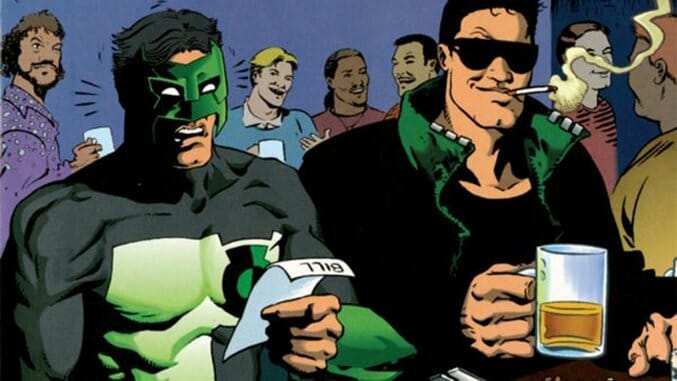Whether in Outer Space or Alternate Dimensions, Comic Book Bars Bring Characters Down to Earth
Main Art by John McCrea from Hitman #11
No matter where you are, you probably don’t have to go far to find a bar. Fortunately for the fictional occupants of comic books, most of them don’t have to go far, either. Whether you’re a scumbag looking for respite or a superhero looking for a scumbag, there’s a comic book bar for you. And whether the comic is realistic, cosmic or somewhere in between, the bar setting creates atmosphere and relatability for readers.

Noonan’s, Hitman, Art by John McCrea
In some comics, a bar is practically another character, taking on a role similar to cities like Gotham or Astro City. In Garth Ennis and John McCrea’s Hitman, Noonan’s—full name, Noonan’s Sleazy Bar—is a comforting home base for a collection of antiheroes and doofuses. Superpowered assassin Tommy Monaghan goes to Noonan’s to drink and hang out with best friend Natt, rival hitman Ringo and father substitute Sean (Noonan’s owner). Meanwhile, sloppy drunk Sixpack and the rest of superhero spoofs Section 8—including the perverted Bueno Excellente and a demon endlessly proclaiming “I am Baytor!”—ranted and raved, like real-life bar weirdos (and they still do, in the current miniseries Six-Pack and Dogwelder by Ennis and Russell Braun). Everyone is welcome at Noonan’s, more or less. It’s a haven for the creepy, the weary and the thirsty.
In Steve Orlando and ACO’s recent Midnighter series, Boston bar Al’s Masse was crucial in the development of the main character. Midnighter, created by Warren Ellis and Bryan Hitch in Stormwatch, has always been an openly gay badass. But most stories after Ellis and Hitch’s sequel series, The Authority, disappointed, and the character was neglected for years. Orlando used scenes in Al’s Masse—chatting with Tony the bartender, playing pool, talking trash—to add layers to a character who is literally a fighting machine, usually treated as only that. By showing Midnighter chatting with Tony about the difficulties of fostering relationships while making time to kill bastards, Orlando proved that even a superhuman with a murder computer in his brain is sometimes just a guy in a bar.
Probably due to some lingering odor of the Comics Code Authority or other prudishness, comic bars are often associated with bad guys. Many watering holes are, as Obi-Wan put it, “a wretched hive of scum and villainy.” Lowlifes abound at Josie’s, which might be the most famous comic book bar (debuting in Daredevil #160). Josie’s has long been a favorite spot for Daredevil to rough up criminals in search of a lead—particularly poor, bumbling Turk. The version of Josie’s on the Daredevil Netflix show is more upscale and less crime-soaked, but still serves an important purpose: it’s the preferred dive of Foggy and Karen, who need a drink quite often.

Kadie’s Club Pecos, Sin City, Art by Frank Miller
-

-

-

-

-

-

-

-

-

-

-

-

-

-

-

-

-

-

-

-

-

-

-

-

-

-

-

-

-

-

-

-

-

-

-

-

-

-

-

-









































